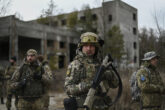September 17, 2019
Trump’s Defense Cuts in Europe Will Backfire
Twice this month, the Trump administration moved to walk back critical efforts to strengthen the U.S. military presence in Europe, choosing cheap political points over essential projects and sound policy. First, the White House announced it would cut more than $770 million worth of military construction efforts meant to restore combat capability in Europe and to deter further Russian aggression, in order to divert funds to build a wall on the U.S.-Mexico border. Second, the United States is hoping to cut a deal with Germany that on its face appears to increase German military spending and decrease the U.S. share of the military burden in Europe but, in reality, serves to weaken the German military while burdening the United States even further. In both cases, the loser is the United States.
The military construction projects on the chopping block include vital aspects of the U.S. scramble to rebuild its ability to fight in Europe. As the U.S. deputy assistant secretary of defense in charge of Europe and NATO when Russia invaded Ukraine in 2014, I spent almost every waking moment pushing as much U.S. force structure back into Europe as I could to deter any further aggression by Russian President Vladimir Putin. I know firsthand how essential the projects in question are, and I know for a fact that eliminating them takes away tools the U.S. military needs in case of a conflict, including ammunition storage, runways for combat aircraft, facilities for special operations forces, prepositioned equipment to set up forward air bases, and reinforced shelters for combat aircraft. The projects being cut are not military bands or barber shops but tools of war that would be needed immediately in case of conflict. Deterrence is about not just showing intent to defend your allies, but having the ability to do so. These cuts take away that ability. The U.S. drawdown in Europe at the end of the Cold War helped embolden Putin to invade Georgia and Ukraine, as well as intimidate U.S. allies in the Nordic and Baltic regions. To deter further Russian adventurism in this great power competition, the United States’ ability to respond alongside NATO needs to be restored, and quickly.
Read the full article in Foreign Policy.
More from CNAS
-
Ukraine Negotiations: Prospects and Pitfalls of Peace
This week Brussels Sprouts breaks down the latest negotiations on Ukraine. American officials told reporters that they had resolved or closed gaps around 90 percent of their d...
By Andrea Kendall-Taylor & Jim Townsend
-
Transatlantic Security / Middle East Security
The Russia-Iran Partnership: A Geopolitical Balancing ActIt has been almost a year since Russia and Iran signed their comprehensive strategic partnership. That deal established a 20-year partnership between the two countries coverin...
By Andrea Kendall-Taylor & Jim Townsend
-
Defense / Transatlantic Security
Ukraine’s Catch-22 MomentThis article was originally published in the Financial Times. In Joseph Heller’s wartime classic, Catch-22, the protagonist Yossarian seeks out the US army surgeon Doc Daneeka...
By Franz-Stefan Gady
-
Ex-Nato Supreme Allied Commander Warns of Russia’s Territorial Ambitions
Gen. Philip Breedlove (Ret.), member of the CNAS board of advisors, told Fox News Digital he sees “a lot of truth” in the German foreign minister’s warning about Russia, sayin...
By Philip Breedlove




